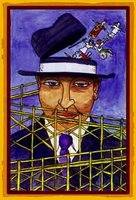Why can't we get it?
More on U.S. money....
Of the 180 countries that have paper currency, the United States is the only one that has bills not distinguishable by touch.
The Bush administration said today that it will appeal the November 28th decision made by Judge James Robertson requiring U.S. paper money be made accessible to people who are blind. Robertson said that the current currency discriminates against those who are visually impaired. The Treasury says that changing the current system would be too costly, too difficult, and is unnecessary.
However, according to the American Council of the Blind, the government has not conducted any feasibility studies to study and examine possible changes. The Council has been advocating for a change to the paper money system to better accommodate people with visual impairments since 1995. They have made proposals such as embossed marks on bills and cut patterns on the sides of bills - both would let one distinguish bills by touch. Another possibility is varying the sizes of different denominations. To help offset costs, the American Council of the Blind is willing to accept a gradual phase-in of changes as old currency is replaced.
The US Treasury claims that changes in our paper currency are not necessary because people who are blind can use credit cards and money readers. However, according to an NPR report, many people who are blind do not use these devices because they are too expensive. And, it is well-known that people with disabilities often struggle financially and may not have access to credit cards. It seems to me that the money readers are not all that handy and don't fit in one's wallet or pocket. People with visual impairments seem to devise their own methods of sorting bills, such as folding the different denominations in different ways, asking for help, or putting different denominations in different pockets, socks, etc.
It's been at least 12 years and two presidential administrations, since the American Council of the Blind has been advocating on this issue. Other countries have figured it out. Yet, the United States has not even had a feasibility study. We don't even want to take a real look at the issue! Japanese bills with raised watermarks on the corners
Japanese bills with raised watermarks on the corners
Malaysian currency with raised geometric shapes Euro has different sizes and colors for different denominations.
Euro has different sizes and colors for different denominations.
Dutch banknotes also have raised marks.
All pictures from NPR.










1 comment:
How much more do we need to prove that this administration could care less about those with disabilities? Oh, the cost!? One days worth of Iraq would pay for most of the cost. Give it a rest. Who pays $10,000 for a toilet seat (*said whining* "because we have a contract") and then doesn't give a flip about the citizens. Hello, the whole idea of representation is a voice for ALL people.
Post a Comment